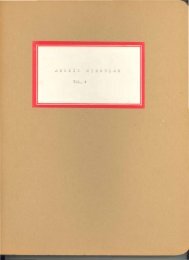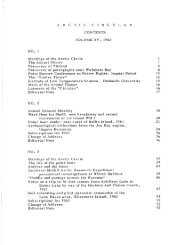Volume 11, 1958 - The Arctic Circle - Home
Volume 11, 1958 - The Arctic Circle - Home
Volume 11, 1958 - The Arctic Circle - Home
Create successful ePaper yourself
Turn your PDF publications into a flip-book with our unique Google optimized e-Paper software.
VOL XI No 1 THE ARCTIC CIRCULAR 9<br />
then skirted the north side ofthe Mer de Glace Agassiz and along<br />
Archer Fiord to Fort Conger, where we landed. After spending<br />
several hours at Greely's campsite we continued north reaching<br />
Alert in the evening. Here we carried out a thorough check of<br />
the aircraft before continuing along the north coast as far as<br />
Cape Columbia, landing on the ice cap near Peary's cairn<br />
atop Cooper Key Mountain. Our return to Eureka lay along the<br />
same route as far as Archer Fiord. Here the head of the fiord<br />
was closed by bad weather so we first turned south but there was<br />
no improvement and we turned back and landed west of Archer<br />
Fiord on a tributary of the Dodge River. Better weather the next<br />
afternoon allowed us to return to Eureka on August 12.<br />
After one day spent in local flights to complete the<br />
film work, I left Mr. Muir at Eureka and returned alone to<br />
Resolute, following much the same route as before. Eureka Sound<br />
was open but the ice had still not moved out of Norwegian Bay.<br />
From Resolute I again went south to Boothia Peninsula and then to<br />
the Shoran site on King William Island. After a short stop here I<br />
continued on to Pelly Lake arriving on August 15. Altogether the<br />
trip had taken <strong>11</strong> days with a total of 50 flying hours and a distance<br />
of 4,500 miles.<br />
Throughout the flights I passed position reports every<br />
thirty minutes to the near~st radio station, and I was never out<br />
of contact. I used a Lear RCBB-T30 combination with a 300-foot<br />
trailing antenna enabling me to tune in on the 3/4-wave length of the<br />
H.F. frequencies I was using. For operation on the ground I carried<br />
balloons and a hydrogen ger.erator to provide a vertical antenna. <strong>The</strong><br />
radio was most effective and from the north coast of Ellesmere<br />
Island I was able to have excellent two-way R/T communications<br />
with the Spartan stations at Pelly Lake, Coral Harbour, and King<br />
William Island.<br />
On all flights I carried concentrated emergency rations<br />
'for thirty days, a tent, sleeping bag, and other standard survival<br />
equipment. I also had a complete spare set of radio tubes, which<br />
proved fortunate as one tube waS required.<br />
<strong>The</strong> experience of the trip more than fulfilled my<br />
expectations and confirmed my convictions that a Super Cub could<br />
provide a service in the far north which could only be replaced by<br />
the complexity and high cost of a helicopter operation.<br />
L<br />
_












